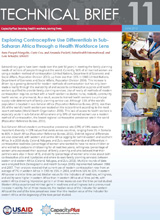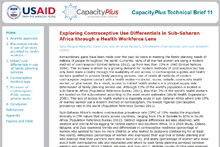
New Publication Spotlight: Exploring Contraceptive Use Differentials in Sub-Saharan Africa through a Health Workforce Lens
The good news is that more and more women around the world are gaining access to family planning services. These days 56% of all married women are using a modern method of contraception, marking a big increase from less than 10% in 1960. The bad news is that only 19% of married women in sub-Saharan Africa are using a modern method of contraception. Since nearly all family planning services require assistance from a health worker, access to health workers is a principal supply-side determinant of family planning service use. In Exploring Contraceptive Use Differentials in Sub-Saharan Africa through a Health Workforce Lens, authors Sara Pacqué-Margolis, Carie Cox, Amanda Puckett, and Lois Schaefer present findings from a study that explored if and how health workforce measures differ between eastern and western Africa, in an effort to identify factors that may have helped some countries to achieve important gains in contraceptive prevalence while other countries have not.
In Exploring Contraceptive Use Differentials in Sub-Saharan Africa through a Health Workforce Lens, authors Sara Pacqué-Margolis, Carie Cox, Amanda Puckett, and Lois Schaefer present findings from a study that explored if and how health workforce measures differ between eastern and western Africa, in an effort to identify factors that may have helped some countries to achieve important gains in contraceptive prevalence while other countries have not.
Sub-Saharan Africa’s modern contraceptive prevalence rate is 19%. However, behind this figure there is a lot of diversity among countries. Somalia, for example, has a contraceptive prevalence rate of just 1%, while South Africa has a rate of 60%. There are also distinct regional differences—western and central Africa lag far behind eastern and southern Africa in terms of contraceptive prevalence.
This new data-rich technical brief discusses findings related to macrolevel trends in use of services provided by health workers, urban/rural differentials in use of family planning services, contraceptive method type, and public-sector versus private-sector provision of contraception. The authors propose how various health workforce factors may be affecting access to modern methods of contraception in sub-Saharan Africa. Their findings raise questions about whether government commitment and certain policy choices vis-à-vis health workforce distribution and qualifications—even when absolute levels of health worker density are low—could make a difference in the provision of family planning services in resource-constrained countries.
Their findings raise questions about whether government commitment and certain policy choices vis-à-vis health workforce distribution and qualifications—even when absolute levels of health worker density are low—could make a difference in the provision of family planning services in resource-constrained countries.
To learn more, read the new publication, available as a PDF and an interactive online version. And please let us know what you think; we welcome your feedback.
Help CapacityPlus spread the word about strengthening the health workforce. Follow us on Twitter and like us on Facebook.
Related items:


